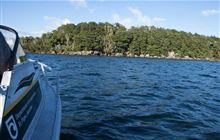Te Whanganui-o-Hei/Cathedral Cove Marine Reserve
Located in Hahei area in the Coromandel region
|
Introduction
The reserve protects a wide range of habitats from sandy flats to rocky reefs, offering great snorkelling and diving. Visitors to the reserve can also enjoy swimming, kayaking and viewing the interesting coastal geology.Find things to do and places to stay Te Whanganui-o-Hei/Cathedral Cove Marine Reserve
Boaties are allowed to explore the marine reserve as long as they follow the rules:
- no fishing or taking of any kind
- no feeding the fish or discharging anything into the water.
Do not exceed five knots within 200 m of the shore or a dive flag, or within 50 m of any other boat or person in the water.
Extra caution may be needed in some areas, especially in summer due to the number of divers and swimmers.
The closest boat ramps to the marine reserve are Cooks Beach and Whitianga Boat ramp.
The marine reserve provides a unique opportunity to see what our coastal marine environment looks like without the pressures of fishing.
Snorkelling and scuba diving allows you to experience the diverse habitats and marine life that the reserve has to offer.
At Gemstone Bay there is a snorkel trail with marker buoys that have information panels on species and habitats. These are moored from 50 m to 150 m offshore.
Visitors to the area should swim or dive in pairs. Snorkelers should wear a wetsuit and life jacket (or use another flotation device such as a boogie board) when snorkelling in the marine reserve. This is particularly important for visitors who are not strong swimmers or used to swimming in the open sea.
Read about how to keep safe while snorkelling and diving at Water Safety New Zealand's Underwater safety webpage.
Kayaking is great way to explore the reserve if you don’t want to get in the water. Kayaks can be hired at Hahei.
Kayak from Hahei beach north along the coast to see Gemstone Bay, Stingray Bay and Cathedral Cove. There are plenty of interesting features such as caves and archways along the coastline to explore.
If you are a confident kayaker, you can kayak around the various islands in the marine reserve which are around 800 m–1 km offshore.
Inexperienced paddlers should take care with the sea conditions and currents.
Hahei and Cathedral Cove beaches are excellent for swimming.
Be aware the marine reserve is currently only accessible via water, due to the current Cathedral Cove walk track closure.
Travelling by car, the trip is about one and a half hours drive from Thames in the west, and about two and a half hours drive from Auckland.
From Thames on the eastern side of the Coromandel Peninsula, travel east across SH25A which then joins SH25. Travel north on SH25 towards Whitianga and follow the signs to Hahei.
To help protect marine life inside the reserve, remember:
- no fishing of any kind, either from a boat or from shore
- no taking or disturbing any marine life, including shellfish and seaweeds
- no taking of any part of the sea floor, including rocks and shells
- no feeding the fish as it disturbs their natural behaviour.
Penalties for failure to comply under the Marine Reserves Act 1971 include confiscation of equipment, vessels or vehicles, fines and imprisonment.
Be aware of the boating rules of marine reserves (see the Marine Reserves Regulations 1993):
- The maximum speed permitted for all boats in New Zealand is 5 knots (about 9 km/h) within 200 m of shore or any boat with a dive flag, and within 50 m of any other boat or swimmer.
- Waste, ballast and sewage must not be discharged within the reserve.
- Drop your anchor responsibly to avoid damage to the reserve, and use the minimum amount of chain necessary.
Water safety
If you plan to enjoy the water, learn how to stay safe when swimming, boating and fishing.
Te Whanganui-o-Hei/Cathedral Cove Marine Reserve is part of the area first claimed by Hei, a tohunga (priest) on Te Arawa waka at the time of the Polynesian migration to New Zealand, circa 1350 AD.
Hei settled his people on the area around Mercury Bay, asserting ownership by referring to Motueka Island as 'Te Kuraetanga-o-taku-Ihu' ('The outward curve of my nose').
It is said he made this claim near the present day site of Hahei. Hei's descendants, as tangata whenua, still retain a strong ancestral and spiritual attachment to the site, and continue their role as guardians, or kaitiaki, of the resources within it.
Contacts
| Kauaeranga Visitor Centre | |
| Phone: | +64 7 867 9080 |
| Fax: | +64 4 471 1117 |
| Email: | kauaerangavc@doc.govt.nz |
| Address: |
995C Kauaeranga Valley Road Thames 3577 |
| Postal Address: |
PO Box 343 Thames 3540 |
| Full office details | |








